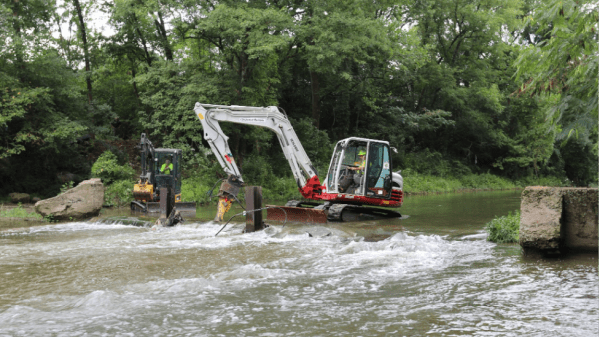Healing the Creek that Runs Through the Heart of Nashville

The Cumberland River basin sits within the third most biodiverse freshwater ecosystem in the world. More than three million people and thousands of species rely on the clean and abundant water in our watershed. Yet across the region, habitat changes continue to threaten precious and rare aquatic ecosystems. Mill Creek is one such ecosystem.
Mill Creek runs through the heart of Nashville. Starting in the small town of Nolensville, it runs under the interstate, along car dealerships, through big-box store parking lots, behind strip malls, past the Nashville airport, and finally into the Cumberland River. Despite its urban route, a wide range of aquatic and terrestrial species including the endangered Nashville Crayfish and the Streamside Salamander still live here.
Since 2015, the Cumberland River Compact has worked to reimagine and restore this crucial urban watershed. We have implemented several innovative, science-based restoration solutions that address the root cause of water impairments across the watershed. We have also engaged and empowered the community to get involved in our work through volunteerism and education programs.
Restoring Free Flows with Dam Removals
We started by inventorying dams in Mill Creek. Equipped with smartphones to record and photograph existing dams, volunteers walked roughly 37 miles of streams. Overall, we found 16 small dams and many additional man-made flow obstructions. Only one of these dams was accounted for in the Army Corps of Engineers National Inventory of Dams, which inventories larger, regulated dams across the country. Most of the dams we found in Mill Creek were built to provide water to farms that once populated the area. Some of these dams were known to natural resource managers, and some were not known. All were barriers to fish and macroinvertebrate passage.
With this inventory in hand, we set off to remove these obstructions. In total, six dams were removed in the Mill Creek watershed, opening up over 50 miles of unobstructed waters. The dam removals enhanced the ecological and hydrological functions of this waterway and restored habitat connectivity for aquatic wildlife like the endangered Nashville Crayfish.
Protecting the Headwaters of Mill Creek

The headwaters of Mill Creek are in Nolensville, Tennessee, a small but booming town. With the building of new homes and schools, the natural hydrology has dramatically changed. To address these changes, the Compact applied the latest principles of bioretention and regenerative stormwater conveyances on the campus of Nolensville High School adjacent to Mill Creek. Over the course of 18 months, the project team completed a series of three stormwater retrofit sites, stream habitat enhancements, and extensive riparian restoration activities. Students from the school were involved in place-based explorations of their campus, restoration activities, and long-term monitoring.
An Innovative Stormwater Control Measure Addresses Stormwater Runoff to Mill Creek at Antioch Middle School
Further upstream in Mill Creek, we installed an innovative stormwater bioswale at Antioch Middle School. Stormwater run-off is one of the main contributors to water quality issues in our region. When heavy rain falls on surfaces like parking lots and roads, that water rushes faster, warmer, and dirtier to nearby streams.
At Antioch Middle School, a 75,000 sq ft parking lot was directing large quantities of unfiltered rainwater into Mill Creek. The velocity of this water leaving the parking lot was contributing to bank erosion, sedimentation, and flooding of Mill Creek.
Traditional bioretention was not possible at this site because it was in the floodplain. Instead, the site was treated with proper grading, soil amendment, Gabion baskets, and dense plantings of native plants and trees. The large-scale bioswale now slows down, naturally infiltrates, and filters run-off from the parking lot before it enters Mill Creek. The site is planted with a suite of native plants and trees including dogwoods, redbuds, cherries, and maples.
The Compact also installed bilingual interpretive signage about the project for users of the popular Mill Creek greenway. We also developed training for Antioch Middle School teachers about how to use the site with their students.
Community Engagement to Support Mill Creek
Reimagining an urban waterway requires deep community involvement. As part of our Adopt-a-Stream program, eleven community groups have adopted a stream segment in Mill Creek and commited to caring for their waterway over a two-year period. Each year thousands of pounds of trash and recycling are removed from Mill Creek and its tributaries by committed volunteers.
When we stop to reimagine Mill Creek, we see it as a healthy and thriving urban stream that is deeply part of the communities it runs near. Our efforts to restore Mill Creek, along with several other partners, are making this vision a reality. As we look to the next 10 years of ecosystem restoration, we cannot wait to see what comes next.
Project Partners and Funders include Tennessee Department of the Environment and Conservation, The US Fish and Wildlife Service, Tennessee Wildlife Resources Agency, KCI Technologies, Metro Water Services, Metro Department of Parks and Recreation, Metro Nashville Public Schools, The Nature Conservancy, Collier Engineering, Williamson County Schools, Wildlife Conservation Society, Patagonia, and The Community Foundation of Middle Tennessee.
The mission of the Cumberland River Compact is to enhance the health and enjoyment of the Cumberland River and its tributaries through education, collaboration, and action. Learn more on our website: https://cumberlandrivercompact.org/